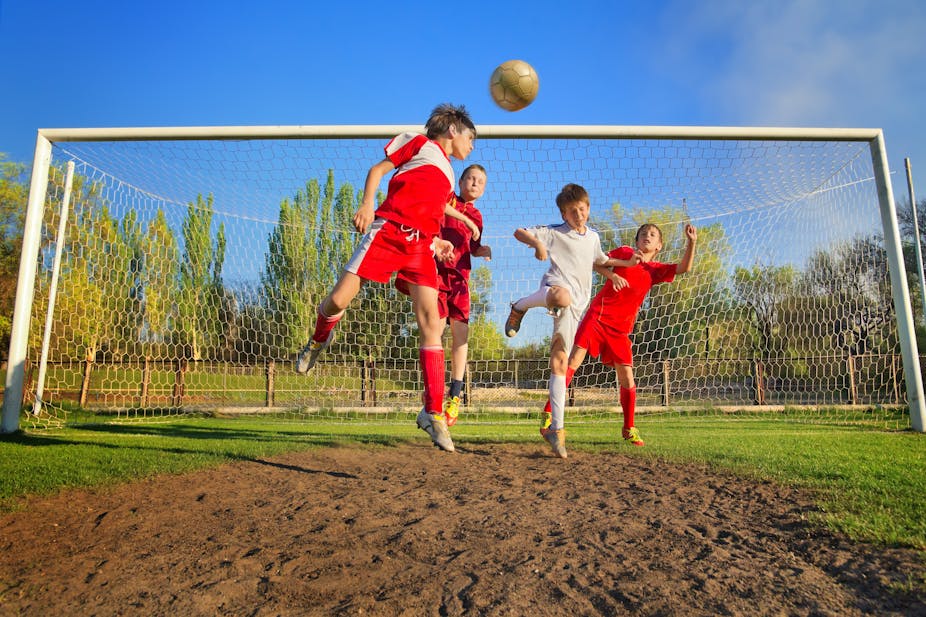This fall, the deaths of three high school football players were linked to direct head injuries on the field of play and one collegiate football player’s death has been potentially attributed to unresolved post concussion syndrome. Even though these athletes were football players, any sporting or recreational events can pose a risk for concussions and head injuries.
Despite the tragic news recently associated with sport, the amazing outcomes of sport participation grossly outweigh the negative consequences of injuries. But injuries should not be considered as just a part of the game, especially when an injury to the brain occurs.
I have been an athletic trainer for sports of all levels for over two decades. And over the past four years, I have fielded more questions from friends and family members about concussions than any other injury during my career. It has become clear to me that parents of youth athletes and their families still need more information about the definition of concussions and symptoms to look for, as well as the appropriate treatment protocols.
Families should know the first step is understanding what makes a child’s brain unique. Then, parents must be ready to take steps to spot concussions and take action.
What makes a child’s brain unique
Concussions are a type of mild traumatic brain injury and are considered to result from a traumatic shaking of the brain. They can cause acute and long-term changes in brain physiology and function including cognition. And for children with developing brains, they can be especially dangerous.
Children have smaller brains in relation to their skulls. Compared to an adult, the young child brain has less mass and more cerebrospinal fluid between the brain and the skull. By way of analogy the child’s brain is like the egg yolk in an egg – there is room for it to move. Because children’s brains have less mass in relation to the skull, their brains experience more acceleration. This means the brain can hit the skull with more force.
A child’s brain also appears to be far more plastic or impressionable than the adult brain. This helps during maturation, but can have negative effects associated with brain injury because the child’s brain is less resistant to trauma.
We can’t fix brain injuries like we can fix damage done to ligaments and bones. Therefore, it is important for parents to be protective when it comes to their children’s brains and to be aware of the potential long-term effects a concussion can have on normal brain development.
Recognizing signs and symptoms
Recent research has shown that parents had misconceptions regarding the definition, symptoms and treatment about concussions.
They didn’t know that concussions can occur from trauma other than a blow to the head and that concussions are considered traumatic brain injuries. They also did not readily recognize key symptoms of concussions including irritability and sleeping difficulties and incorrectly identified arm and leg weakness or numbness as signs, which they are not.
Parents are in a prime position to recognize the signs and symptoms of a concussion in their child. The culture of sport encourages children to play and win so a child will often hide symptoms from medical practitioners. But parents are able to pick up on the subtle signs of problems associated with a previous concussion. Signs and symptoms are usually classified into four categories including physical, cognitive, emotional and sleep patterns.
The physical signs and symptoms include, but are not limited to, headache, loss of consciousness, dizziness or balance problems, numbness, tingling, fatigue, visual problems, diminished pupil reaction, dazed or stunned expressions, ringing of ears, sensitivity to light and noise, and vomiting.
The cognitive responses include mental slowing or fogginess and the emotional signs and symptoms include irritability, uncharacteristic actions, anxiety, sadness and depression.
Sleep pattern changes including excessive drowsiness, trouble falling asleep and altered patterns of sleep and wakefulness are also common.
Return to play and return to learn
Unfortunately, the return to play and return to learn (or classroom) guidelines are not widely understood by parents because of communication gaps in the medical community. If children are treated by emergency room physicians or pediatricians these professionals are often not trained in the long-term management of concussions. This means that children often return to school or athletics too soon.
Often the focus for a child athlete is mainly on return to play but equally important is the return to learn or the classroom and academics. The cornerstone for both the return to play and return to learn plans are REST – physical and cognitive. A child must rest by limiting physical and mental activity (this means reading, TV, games, texting and computer time).
Concussions can cause a metabolic crisis for the brain because blood flow and glucose delivery are impaired. The brain needs energy to function normally and to heal itself, and these metabolic changes mean the active brain may not get as much energy as it normally needs to function properly. This is why rest is important to recovery.
Children with concussions symptoms should be removed from the classroom and provided with work to do at home. Work sessions should remain short with frequent breaks When a child is able to read for 30 minutes without increasing signs or symptoms then a progressive return to school can begin (half days to full days). Resuming physical activity should be progressive as well.
Following these guidelines can help parents to be protective of their children’s brains and potentially prevent long-term effects or tragic consequences.

